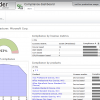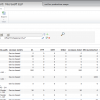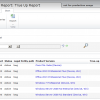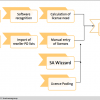Brainware Spider for Microsoft License Management
 This is an independent review of technology for managing Microsoft licensing and agreements.
This is an independent review of technology for managing Microsoft licensing and agreements.
Also participating in this review:
A full comparison and Group Test results can be found here: https://marketplace.itassetmanagement.net/2014/10/02/microsoft-license-management/
Executive Summary
| Elevator pitch | A strong competitive offering for management of Microsoft licensing. Features for managing Microsoft licensing and agreements includes Microsoft suite detection, parallel or secondary usage product use rights, tracking of usage within virtual environments, management of client access licences and calculation of upgrade, downgrade and software assurance rights. |
| Strengths |
|
| Weaknesses |
|
| Primary Market Focus |
|
Commercial Summary
| Vendor | brainwaregroup |
| Product | Spider Licence |
| Version Reviewed | 6.1 |
| Date of version release | August 2013 |
| Year founded | 2001 (Merged with brainwaregroup 2010) |
| Customers | 200+ |
| Pricing structure | Priced per managed device. |
Rating
| Microsoft Licence Management Features |
Rating |
| General features that aid Microsoft licence management |
[icon name=”star”][icon name=”star”][icon name=”star”][icon name=”star”] |
| Microsoft software recognition |
[icon name=”star”][icon name=”star”][icon name=”star”][icon name=”star”] |
| Microsoft product family and suite recognition |
[icon name=”star”][icon name=”star”][icon name=”star”][icon name=”star”] |
| Management of Microsoft licensing types |
[icon name=”star”][icon name=”star”][icon name=”star”][icon name=”star”] |
| Efficient Microsoft spend (low risk, low waste) |
[icon name=”star”][icon name=”star”][icon name=”star”][icon name=”star”] |
| Microsoft contracts management |
[icon name=”star”][icon name=”star”][icon name=”star”][icon name=”star”] |
Key to Ratings
|
[icon name=”star”][icon name=”star”][icon name=”star”][icon name=”star”][icon name=”star”] |
Strong |
Market leader |
|
[icon name=”star”][icon name=”star”][icon name=”star”][icon name=”star”] |
Good |
Well executed and competitive offering |
|
[icon name=”star”][icon name=”star”][icon name=”star”] |
OK |
Adequate, meets requirements |
|
[icon name=”star”][icon name=”star”] |
Weak |
Poorly or partially executed |
|
[icon name=”star”] |
Absent |
Missing key requirements |
Independent Review
Brainware group offers a solution for managing Microsoft licensing called Spider Licence.
The Spider technology has been developed since 1999; originally as a standalone licence management tool which then merged with the Brainware Solutions AG in 2010 and became part of brainwaregroup. brainwaregroup include systems management tools under the “Columbus” brand such as inventory, deployment and remote control. Spider is also available as a SaaS offering known as “SAM Cloud”.
It has been a while since The ITAM Review reviewed Spider Licence, our last review was for our Tools Intelligence assessment back in 2010 when the solution was rated second out of six leading enterprise licence management tool sets (see ‘Market Synopsis: Enterprise SAM Tools’).
Back in 2010 our assessment concluded that Spider was a strong competitive licence management solution, but with a rather clumsy interface. In the intervening years Spider has come along in leaps and bounds and is still a competitive offering for licence management for complex enterprises. The interface has also improved dramatically over the last years, although may still not be on a par with others in this review. In our opinion aesthetics are not a showstopper in tool choice, but can be quite important in adoption and everyday use.
Spider Licence claim their technology recognises over 98% of Microsoft titles and offer comprehensive coverage of Microsoft licence types, devices and platforms.
Features for managing Microsoft licensing and agreements includes Microsoft suite detection, parallel or secondary usage product use rights, tracking of usage within virtual environments, management of client access licences and calculation of upgrade, downgrade and software assurance rights.
Spider use a SKU based approach to licence management with a logical methodology for balancing licensing procurement history and installation or configuration data. It is an open system rather than a black box approach – so Software Asset Managers can see and if necessary override any system settings in case they have negotiated special terms with software publishers.
Spider has the ability to interface with VMware, Hyper-V, and Citrix and can track Office 365 usage via the use of their External Data Collector (EDC) technology and can calculate the appropriate virtual Microsoft product use rights that apply. We also liked the way it is easy to display all the licences assigned to either a device or an employee or any other organizational dimension. Spider licence also includes features for managing the complexities of Microsoft contracts, agreements and enrolments including email alerting around major contract dates, licence pooling for maximum advantage, collating points and managing Microsoft software assurance entitlement.
The ITAM Review believes Spider is a strong competitor for organizations looking for licence management solutions, the company would benefit from more participation in the industry outside central Europe to make sure organizations shortlisting tools are fully aware of their capabilities.
Screenshots
In their own words
“Spider Licence has strong functionality to support the management of Microsoft licences. As with any good licence management product, the key to a good result begins with quality data. Our EDC technology allows for the standardised collection methods of software installation data from Windows devices across multiple different networks and can be scheduled to ensure a bandwidth friendly delivery of that data back. Our Advanced Discovery scanning capabilities allow us to collect key information related to licence management such as CPU and core counts from a hardware perspective, as well as edition information for SQL and embedded OS information for Windows.
In addition to our own scanning capabilities, we have product interfaces to SCCM, Microsoft Assessment and Planning Toolkit (MAP), LANDESK and many others. After the software detection, the Spider Recognition Module identifies the licence relevant products out of the huge amount of files and registry keys. We achieve a recognition rate of more than 98% for Microsoft products. The recognition maps the detected software to a product version in our catalogue, which contains over 320.000 unique articles. For each product version, we leverage Licence Metric Procedures (LMPs), which evolve to cope with the licensing changes of the vendors we manage. These rules allow for the detection and leverage of rights related to:
- Microsoft suite detection
- Multiple installations on virtualised OSEs via the host’s licence
- Secondary usage rights
- Usage in virtual environments
- Automatic version upgrade with SA
- Converting the cores/processors figure to the correct licence demand for each product (e.g. minimum core commitments for SQL; two processors requiring one licence for Windows Server)
Entitlements can be imported from MVLS reports, lists from resellers or by importing a Microsoft Licence Statement (MLS). All Microsoft contracts, their relationships and all accompanying documents can be managed with Spider Licence.
The resulting benefits include:
- Extensive reporting on Microsoft product usage, e.g. Effective Licence Position or True-up
- Full transparency about software usage, purchase history and upgrade paths
- Quick access to all licence documents (SLT, contracts, side agreements) and proof of licences (invoices, COAs etc.)”
- The ability to assign licences and keys to individual devices or users
- The granularity to approve installations of applications individually and report on estate changes so cross charging and licence assignation becomes a transparent part of licence management.
Further Reading
- Spider Licence Product Page: https://www.brainwaregroup.com/en-ch/products/spider-licence.html
Case Studies
- Itergo, Düsseldorf, Germany.
- Swisscom, Bern, Switzerland
- SBB, Bern, Switzerland
- Vodafone
- Linde Group, München, Germany
About Martin Thompson
Martin is also the founder of ITAM Forum, a not-for-profit trade body for the ITAM industry created to raise the profile of the profession and bring an organisational certification to market. On a voluntary basis Martin is a contributor to ISO WG21 which develops the ITAM International Standard ISO/IEC 19770.
He is also the author of the book "Practical ITAM - The essential guide for IT Asset Managers", a book that describes how to get started and make a difference in the field of IT Asset Management. In addition, Martin developed the PITAM training course and certification.
Prior to founding the ITAM Review in 2008 Martin worked for Centennial Software (Ivanti), Silicon Graphics, CA Technologies and Computer 2000 (Tech Data).
When not working, Martin likes to Ski, Hike, Motorbike and spend time with his young family.
Connect with Martin on LinkedIn.





